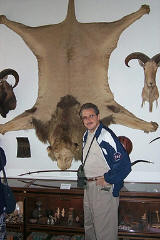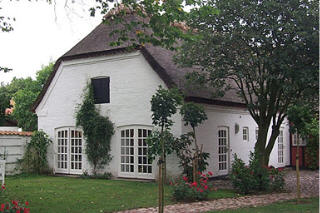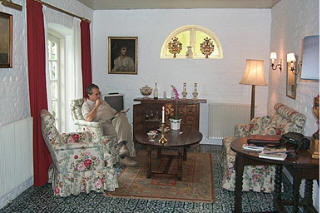Ron writes:
We visited a wonderful Viking Museum in Ribe, Denmark, looking for the answer to this burning question, but either they don't know or it's a big secret around here and they aren't telling. By watching a film and taking meticulous notes I did learn that in 9th Century Denmark, the average age at death was 22, but the average age before death is only 21 and every skeleton in the place had its two front teeth missing, the women seem to outlive the men by five to eight years and their pelvic cavity is wider in order to give birth to a 6' 4" Viking son (or daughter). These facts all help me to understand why Denmark was the first NATO country to authorize women fighting on the front lines.
Almost all towns have designated bike paths and they are so ubiquitous you are in more danger of being hit by a bike than a car. By the time we got use to looking right as we step off of a curb in England, we then faced a double threat in Denmark of the "bike path" between the sidewalk and the street with bikes coming from both directions followed by the perilous journey across the boulevard where taxi drivers have the right-of-way and come at you from the standard American direction and all the while you trying to remember where you are and at the same time take photographs for the Ramble. And moreover, bikers, having been given their own special lane in which to ride, think that the pedestrian has no rights in their space and since they announce their arrival with these little annoying bells (ching-ching) that sound very much like the all clear to cross chirp we have brushed death several times.
Susan writes: Scandinavia Well, we’have sailed the coasts of Norway, stopped into Sweden briefly in the lively town of Goteborg, and barreled through Denmark.. Now we find ourselves in Dublin and where we were and what we saw in Scandinavia is beginning to fade as we explore Ireland. We've got to get this version out in to cyberland so I can concentrate on what we're experiencing in the land of the leprechauns and forget about the Great Danes. It feels odd being a travel journalist on a deadline! It's a suspension of time, a sort of knot in the tread of continuum. I'm not used to keeping things in my head for so long. You who call yourselves my friends know this, eh? Well, to part the week old cobwebs and search for recent memories. we got off the ship, disembarked I think it’s called, and checked in to a dark little room in the Hotel Kong Arthur in rainy Copenhagen, pulled on our windbreakers and sloshed around trying to see the town. The hotel nicely provides umbrellas. Forgot the camera, of course, but it was so dreary it wasn't particularly photogenic unless you're the moody sort, which I am, but wasn't, and despite the wet streets and chill we liked the city quite a bit. It was pretty user-friendly as cities go. A great central portion is pedestrianized, a series of streets called the Sloget, and it is here that all of Denmark's , and a good portion of Europe's, young adults walk up and down wearing their black fashions and looking sophisticated and knowing. There is an entire generation in Europe that owns nothing but black clothing. So we strolled up and down, feeling self conscious in our bright Gap clothes. The rain let up enough for a visit to Tivoli Gardens, the famous and wonderful amusement park in the heart of Copenhagen that was much, much larger when I visited it as a child (although I was told it was exactly the same size, but I don’t believe it) but the drizzle started back up and stayed with us off and on for the duration of our stay in Denmark. However, I was glad to see the sun set again at a proper hour, I had missed a real nighttime further north. It’s too strange having that long twilight, you never really get a good night’s rest. A cab driver told us that you feel tired all the time living through the Norwegian winters, you sleep more than usual, but the summer’s never-ending twilight is equally hard on those circadian rhythms. At least they were on mine! And we never really saw the famous midnight sun because of the cloud cover. We still can’t pronounce a single word in any of these Nordic languages. We have
been trying to always learn a few words of the native tongue but here it’s
impossible. Just reading the road signs is daunting and trying to wrap your tongue around
something like Steensgaard Herregardspension (the name of a hotel) or Tisvildeleje or
Himmelbjerget (names of places, the last means "sky mountain" and is the highest
hill in Denmark, a whopping 150 meters or so) is totally off-putting. There are even some
vowelless words like spsk. I don’t know what it means, I read it in a recipe in a
cooking magazine. And even if you can get all those consonants out in one breath, the
pronunciation is not the same as English. Ry is the name of a village in the Danish Lake
District. Damned if we could get directions asking for "Rye" (as in toast)
since it’s pronounced "reu" like the French eu. We would have been
toast trying to get there, but thankfully, the Danes, besides being extraordinarily
handsome, are multilingual. They begin English lessons in the third grade and in seventh
begin their study of German or French. (At least they have it in the right order, said the
Imperialist...) We were told that their English remains fluent because of films: no one
would dream of subtitling films in Danish so they watch all the movies in the
original! So, thanks to Hollywood, most of the people we met spoke English fluently and
mostly unaccented. And (no) thanks to CNN they are all learning to wear black and covet
the American pop culture. I learned that Swedish, Norwegian and Danish are somewhat
similar languages, but Finish is totally different, once again somehow related to
Hungarian, like the Samic languages up at the Nordcapp. The only person we met who did not
speak any English at all was a lovely old gent who gave us a wonderful tour of a Molle, a
windmill, and we understood everything. Sort of. The entire Danish country, all 500 islands of it, is half the size of Maine. It’s
disorienting to try to read the maps because an inch is about 500 meters! The little towns
come right after one another, little red brick, deep roofed houses, sometimes thatched,
and tiny squares in the center. How do these big Danes live in such small houses?
We’have driven a good bit of the country, dashing right across to Jutland, the
peninsula that sticks up from Europe to the prettiest, village in Denmark called Ribe.
Very Hans Christian Andersony. Almost too precious, but a lot of work has been expended
preserving this town which is supposed to be the oldest in Denmark. When we checked
into the oldest hotel in Ribe I realized the Danes were shorter once upon a time, they
must have been. We could barely stand up in the room. There was a beautiful church
in the square, outside our window, Denmark is gorgeous. So beautiful! It’s a soft green rolling land, spiked with groves of white windmills that for all their high tech appearance and function are very elegant. The natives are very friendly and although tall are kind to short folks. Statuesque hardly describes the Danish folk. They are truly all blond, very tall, very well built. The women have longer thigh bones than my entire leg hip to ankle. I feel short here. I will never tease my short friends again. I’m not sure about these myths of the Vikings raping and looting: when those fellows jumped out of their long boats those primitive villagers must have thought them gods and lined up to hand over their wealth and their women! An expert in folklore that we met on the plane to Edinburgh told us that the Vikings may have originally come from the Steppes of Russia, and followed the melting icecaps north. They all have brilliant white teeth, and smooth tanned skin. This may be because their month long holiday has just ended and they’have all been to Italy mixing it up with the Americans there. I’m pretty sure they did not’t get the tan in Denmark. It rains every fifteen minutes. The other fifteen the sky is a gorgeous cerulean blue. They say the purest air in the world is found up here. Up north in Skagen (pronounced "skane") the Danes like to say that the nearest factory is 500 miles away, in Scotland. They even tax themselves a Green Tax most of which goes to the Russians to help clean up those nuclear power plants that spew pollution over the borders. They have the highest taxes and the highest suicide rate in the world. I am sure there's a connection.
After leaving the castle we drove a few miles, looking for a place to stay. Almost
stayed at another castle that had bedrooms with silk draperies but it was too eerie, we
were the only ones there and I was afraid we’d vanish along with the castle in the
night, just like a fairy tale, so we drove on and came to the Faldsled Inn. The buildings
were thatched and half-timbered, our room, number 6, had blue tile floors and a
whitewashed fireplace and French doors that looked on to a rose garden that was bordered
by meadows that fell to the sea. It was our last night in the country before going
back to Copenhagen and catching our flight and we could hardly believe our luck. We could see the masts of sailboats in the tiny harbor and watch the fishermen in their
funny little boats with houses on them go out to sea, and at dinner, in the glass dining
room, we watched acrobatic swallows and golden clouds while eating a really wonderful
meal. Denmark is not noted for great food, but this was spectacular. In fact, the inn is
owned by the chef. He's one of those Great and Famous Chefs who make food that
looks like art. It took as long as art to make as well, but it was hard to complain,
the evening was so beautiful and what a wonderful way to grow old: waiting for dinner.
That's our hotel room up above, and below, doesn't Ron look comfy? While everyone
in Atlanta was broiling with the August heat, we were sitting by a fire on a cool
and misty Nordic night. We want to come back to this place someday. We never got to Elsinor or Odense and Skagen is a must. Then back to Copenhagen, that stony city of silent people. The Danes are so soft spoken that in a pedestrian street full of young people there is no sound, no babble of voices at all, until someone passes you and only a slight murmur lets you know they are speaking to their companion. I feel that we’re shouting when we carry on a conversation in a restaurant in our normal voices. It’s most disquieting. So to speak. I mean….oh well. The occasional knot of Italians or Spaniards comes by jabbering merrily and you can hear them three blocks away. We broke our rule against airplanes to fly to Edinburgh since we spent our planned travel time touring the countryside of Denmark. It was Friday the 13th and I sat next to a man who had resurrected the ancient art of making gold and silver laces. I’d like to say I was spellbound for two hours, but I’m afraid I learned more about lace than I ever wished.Did you ever wonder who tidied up the gold trims on all those costumes in the museums? No? And so we landed in Edinburgh and the next ramble will take place in Ireland. We did not expect to go to Ireland, so it's a treat to find ourselves here. We had thought we would head back to Copenhagen and then train it to Berlin, but while we are all the way over here, and it's so easy to hop over, we might as well check in with Sinn Fein and see if we can help...we have never seen a revolution. Although this one's a bit long in the tooth. And toothless these days, thank goodness. Hope everyone reading this is well and happy. And thanks for reading!
|

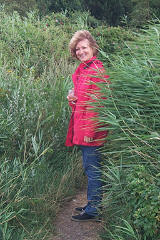 When I stepped off the boat in
Copenhagen, my first impression is this is a land of extremely beautiful people. They're all
blond and statuesque with these white teeth and sparkling blue eyes that light up when
they smile. They're so incredibly beautiful, the women tall and angular and the men
ruggedly handsome, it's difficult to take one's eyes off of them, although I have to admit
I've enjoyed watching the women more than the men, and since Susan shares my enthusiasm
and innocent voyeurism, no harm done and no envy noted. And they are always smiling
and presumably happy and those that have served us in restaurants and hotels do so with
great gusto. The problem that I have been pondering for several days is with all of
these magnificent women around why did the Vikings build these little wooden boats and get
together with their buddies to row across the frigid North Sea to rape and pillage in
foreign countries like Greenland where on a good day the best they're going to find is a
dark skinned, weight challenged, Eskimo women who wants to rub noses. I don't
get it!
When I stepped off the boat in
Copenhagen, my first impression is this is a land of extremely beautiful people. They're all
blond and statuesque with these white teeth and sparkling blue eyes that light up when
they smile. They're so incredibly beautiful, the women tall and angular and the men
ruggedly handsome, it's difficult to take one's eyes off of them, although I have to admit
I've enjoyed watching the women more than the men, and since Susan shares my enthusiasm
and innocent voyeurism, no harm done and no envy noted. And they are always smiling
and presumably happy and those that have served us in restaurants and hotels do so with
great gusto. The problem that I have been pondering for several days is with all of
these magnificent women around why did the Vikings build these little wooden boats and get
together with their buddies to row across the frigid North Sea to rape and pillage in
foreign countries like Greenland where on a good day the best they're going to find is a
dark skinned, weight challenged, Eskimo women who wants to rub noses. I don't
get it! 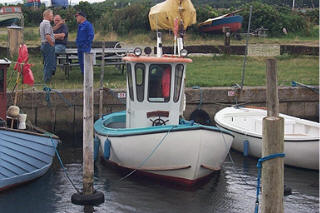 The Vikings were, however,
masterful boat builders, and the Danes still are. They perfected the open cockpit
long boat, with square rig sails power assisted by twenty strong oar pulling men, rear
steerage model VIK001. Today, the Danes go in for a slightly advanced version with
wrap around windows, inside and outside steering wheels, and a central cabin designed to
provide sleeping comfort for one person standing up.
The Vikings were, however,
masterful boat builders, and the Danes still are. They perfected the open cockpit
long boat, with square rig sails power assisted by twenty strong oar pulling men, rear
steerage model VIK001. Today, the Danes go in for a slightly advanced version with
wrap around windows, inside and outside steering wheels, and a central cabin designed to
provide sleeping comfort for one person standing up.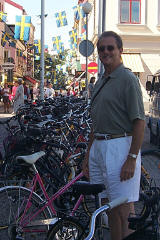 Another popular form of
transportation is the bicycle. The city government provides free bikes in specially
designated areas for anyone who wants one. I've taken advantage of their generosity
and sent one to each of you on our mailing list. You will recognize this gift when it
arrives because it's yellow.
Another popular form of
transportation is the bicycle. The city government provides free bikes in specially
designated areas for anyone who wants one. I've taken advantage of their generosity
and sent one to each of you on our mailing list. You will recognize this gift when it
arrives because it's yellow.  Actually Denmark would be a
wonderful place to die and be buried although I'm not interested in my epitaph saying
"He was run over by a yellow city bike....". The cemeteries are really
quite lovely. Each occupant has a beautifully landscaped burial plot surrounded by
manicured hedges interspersed by an occasional Italian Cypress tree. This reminds me
of growing up in Tampa. I had so many relatives that every weekend we either went to
a wedding or a funeral and the way Italians celebrated these, as a young child, it was
hard to tell the difference. So I've had a lot of experience in cemeteries in Tampa
but none are as beautiful as these in Denmark. However, there is one wonderful
tradition they do in Tampa, the Latin families put a photograph of the interred on the
headstone behind an oval glass window and that way you see what the dead person looked
like in life. Nothing can move you from the morose and morbid thoughts brought on by
a stroll in a cemetery more than the smiling face of a cherished relative looking up at
you from their eternal resting place.
Actually Denmark would be a
wonderful place to die and be buried although I'm not interested in my epitaph saying
"He was run over by a yellow city bike....". The cemeteries are really
quite lovely. Each occupant has a beautifully landscaped burial plot surrounded by
manicured hedges interspersed by an occasional Italian Cypress tree. This reminds me
of growing up in Tampa. I had so many relatives that every weekend we either went to
a wedding or a funeral and the way Italians celebrated these, as a young child, it was
hard to tell the difference. So I've had a lot of experience in cemeteries in Tampa
but none are as beautiful as these in Denmark. However, there is one wonderful
tradition they do in Tampa, the Latin families put a photograph of the interred on the
headstone behind an oval glass window and that way you see what the dead person looked
like in life. Nothing can move you from the morose and morbid thoughts brought on by
a stroll in a cemetery more than the smiling face of a cherished relative looking up at
you from their eternal resting place. I've always been fascinated by
the technical aspects of windmills and the few left in Denmark are works of art equivalent
in some respects to a finely crafted Swiss watch. In fact, we met this elderly gent
who was the caretaker of this windmill and he explained to Susan and I, in Danish, that
originally windmills were built as time clocks, at least I think that's what he said.
He gave us a tour of the inner workings and using intricate hand gestures
punctuated with phrases like "De kan clock hjaelpe Greenwich mean time os med at
opretholde minute un hour hands den venlige og effektive gaestfrihed Y2K compatible der
kendetegner dette windmill of your mind" demonstrated how a windmill can be used to
tell time. First of all, the blades on the long arms can be rotated like a variable
pitch prop to adjust for daylight savings time as well as compensate for when the clock is
running too fast or too slow. Secondly, the propeller on the back is used to swing
the entire windmill 360° so everyone around the town can tell what time it is. This
maneuver also winds the clock. Next, the shaft from the windmill attaches to a set
of gears precisely chiseled out of wood and interlinked with belts and pulleys to this
little round wire basket in which they place a small mouse. The really unique thing
is that Denmarkian mice can run in place in that wire basket for exactly one hour, and
then they die. They have been trained to pull on a lever just before they expire
I've always been fascinated by
the technical aspects of windmills and the few left in Denmark are works of art equivalent
in some respects to a finely crafted Swiss watch. In fact, we met this elderly gent
who was the caretaker of this windmill and he explained to Susan and I, in Danish, that
originally windmills were built as time clocks, at least I think that's what he said.
He gave us a tour of the inner workings and using intricate hand gestures
punctuated with phrases like "De kan clock hjaelpe Greenwich mean time os med at
opretholde minute un hour hands den venlige og effektive gaestfrihed Y2K compatible der
kendetegner dette windmill of your mind" demonstrated how a windmill can be used to
tell time. First of all, the blades on the long arms can be rotated like a variable
pitch prop to adjust for daylight savings time as well as compensate for when the clock is
running too fast or too slow. Secondly, the propeller on the back is used to swing
the entire windmill 360° so everyone around the town can tell what time it is. This
maneuver also winds the clock. Next, the shaft from the windmill attaches to a set
of gears precisely chiseled out of wood and interlinked with belts and pulleys to this
little round wire basket in which they place a small mouse. The really unique thing
is that Denmarkian mice can run in place in that wire basket for exactly one hour, and
then they die. They have been trained to pull on a lever just before they expire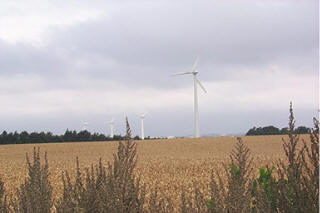 thinking oxygen is coming, but what really happens is that the door to the
cage opens letting in another mouse who pushes the dead mouse out causing its little
wilted body to land on a trigger advancing the hour hand one hour. It wasn't until
people started carrying their windmills with them to business meetings that they realized
the necessity of miniaturization which lead to the discovery of the art of making bread
from flour that could be used to make terrific sandwiches at these meetings. And
guess what they used for meat filling?
thinking oxygen is coming, but what really happens is that the door to the
cage opens letting in another mouse who pushes the dead mouse out causing its little
wilted body to land on a trigger advancing the hour hand one hour. It wasn't until
people started carrying their windmills with them to business meetings that they realized
the necessity of miniaturization which lead to the discovery of the art of making bread
from flour that could be used to make terrific sandwiches at these meetings. And
guess what they used for meat filling?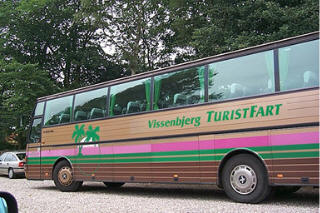 Something is rotten in
the state of Denmark - Well, its time to get on the bus and head to Edinburgh to
meet the Israels once again for a fun filled Edinburgh International Festival. I
have really enjoyed Denmark and am sorry to leave it. The people were marvelous
everywhere we went. It's not a country I ever wanted to come to, but having been I'd
return in a heartbeat.....but bring an umbrella.
Something is rotten in
the state of Denmark - Well, its time to get on the bus and head to Edinburgh to
meet the Israels once again for a fun filled Edinburgh International Festival. I
have really enjoyed Denmark and am sorry to leave it. The people were marvelous
everywhere we went. It's not a country I ever wanted to come to, but having been I'd
return in a heartbeat.....but bring an umbrella.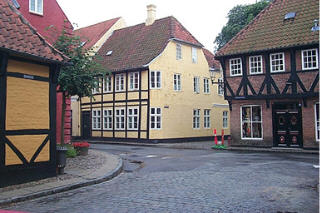
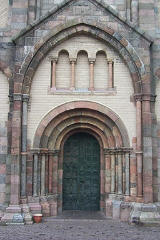 built with multicolored granite
stones that were also used in the street paving. Pinks and blues and violets. Then
up the coast and back across heading east, marveling at the wild coastal dunes and fjords
and then into the interior to the Lake District and the highest hills in the country, all
150 meters tall, with beautiful forests around the lakes and more pretty villages. Only
unsightliness is the modern post war construction you occasionally find in the larger
towns. I do wish they had not allowed any construction in the 50s and 60s. They should
have locked up the post war architects until they got over their shell shock and angst
they suffered in the War.
built with multicolored granite
stones that were also used in the street paving. Pinks and blues and violets. Then
up the coast and back across heading east, marveling at the wild coastal dunes and fjords
and then into the interior to the Lake District and the highest hills in the country, all
150 meters tall, with beautiful forests around the lakes and more pretty villages. Only
unsightliness is the modern post war construction you occasionally find in the larger
towns. I do wish they had not allowed any construction in the 50s and 60s. They should
have locked up the post war architects until they got over their shell shock and angst
they suffered in the War. 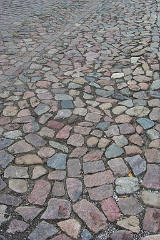
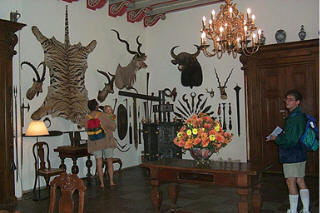 So we wandered for three days. Even spent an afternoon in a
castle full of weapons and animal trophies and hidden staircases. This was when we were on
the island of Fyn. We had left the peninsula of Jutland after agonizing over whether to go
to Skagen, but it was just too far north, way up on the tip of the peninsula and everyone
said it was beautiful and we must go, but it sounded like landscape similar to what we had
seen in Norway, so we decided to go in search of castles and had the great good
fortune to find ourselves in Sydfyn, the southern part of the island of Fyn.
So we wandered for three days. Even spent an afternoon in a
castle full of weapons and animal trophies and hidden staircases. This was when we were on
the island of Fyn. We had left the peninsula of Jutland after agonizing over whether to go
to Skagen, but it was just too far north, way up on the tip of the peninsula and everyone
said it was beautiful and we must go, but it sounded like landscape similar to what we had
seen in Norway, so we decided to go in search of castles and had the great good
fortune to find ourselves in Sydfyn, the southern part of the island of Fyn. 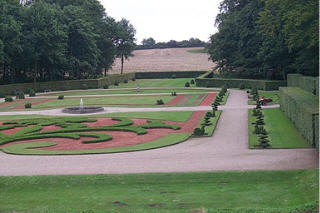 The best castle we found is one of the most beautiful Renaissance
castles in Europe, with an ugly name, Egeskov Slot. That picture up on top in Ron's
section is it. A fairy tale place with a moat and three intricate boxwood mazes (the
largest in Europe, of course...what is it with these Scandinavians and their biggest and
oldest and northernmost?) and huge ten foot tall hedges that surround gorgeous
gardens. The man that owned this castle liked to hunt, and he also liked to hang out in a
room that I think Ron may try to replicate in his next house if I let him. I told
him the skins were out, but some of those weapons would come in handy the next time he and
his buddies play the electric guitar too late up at the lake…
The best castle we found is one of the most beautiful Renaissance
castles in Europe, with an ugly name, Egeskov Slot. That picture up on top in Ron's
section is it. A fairy tale place with a moat and three intricate boxwood mazes (the
largest in Europe, of course...what is it with these Scandinavians and their biggest and
oldest and northernmost?) and huge ten foot tall hedges that surround gorgeous
gardens. The man that owned this castle liked to hunt, and he also liked to hang out in a
room that I think Ron may try to replicate in his next house if I let him. I told
him the skins were out, but some of those weapons would come in handy the next time he and
his buddies play the electric guitar too late up at the lake…